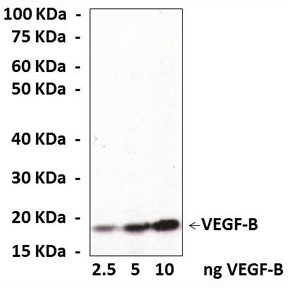Description
BACKGROUND Vascular endothelial growth factor (VEGF) is an important signaling protein involved in both vasculogenesis (the de novo formation of the embryonic circulatory system) and angiogenesis (the growth of blood vessels from pre-existing vasculature). VEGF has several splicing isoforms (in humans: VEGF121, VEGF121b, VEGF145, VEGF165, VEGF165b, VEGF189, VEGF206; the rodent orthologs of these proteins contain one fewer amino acid). They belong to a growth factor family containing other closely-related proteins (PIGF, VEGF-B, VEGF-C, VEGF-D, and PIGF).1 VEGF is sometimes referred to as VEGF-A to differentiate it from these related growth factors. A number of VEGF-related proteins have also been discovered encoded by viruses (VEGF-E) and in the venom of some snakes (VEGF-F).2
All members of the VEGF family stimulate cellular responses by binding to tyrosine kinase receptors (the VEGFRs) on the cell surface. The ligand binding leads to dimerization of receptors and activation of their kinase activity. The activated receptor tyrosine kinases interact with and phosphorylate downstream signaling components including PLC-gamma, p85, and SHC etc, which mediate VEGF-signaling in the cells.3, 4
All members of the VEGF family stimulate cellular responses by binding to tyrosine kinase receptors (the VEGFRs) on the cell surface. The ligand binding leads to dimerization of receptors and activation of their kinase activity. The activated receptor tyrosine kinases interact with and phosphorylate downstream signaling components including PLC-gamma, p85, and SHC etc, which mediate VEGF-signaling in the cells.3, 4
REFERENCES
1. Neufeld, G. et al. FASEB J. 13:9, 1999.
2. Yamazaki, Y. & Morita, T. : Mol. Divers. 10:215, 2006.
3. Shapiro, S. D.: J Clin Invest.106: 1309, 2000.
4. Meyer, R. D. et al. : J. Biol. Chem. 277: 27081, 2002.
2. Yamazaki, Y. & Morita, T. : Mol. Divers. 10:215, 2006.
3. Shapiro, S. D.: J Clin Invest.106: 1309, 2000.
4. Meyer, R. D. et al. : J. Biol. Chem. 277: 27081, 2002.
Products are for research use only. They are not intended for human, animal, or diagnostic applications.
Details
Cat.No.: | CB3876 |
Antigen: | CHO-cell expressed human VEGF-B protein |
Isotype: | Rabbit IgG |
Species & predicted species cross- reactivity ( ): | human |
Applications & Suggested starting dilutions:* | WB 1:1000 IHC (Paraffin) 1:50 |
Predicted Molecular Weight of protein: | 19 kDa |
Specificity/Sensitivity: | Detects human VEGF-B proteins. |
Storage: | Store at -20°C, 4°C for frequent use. Avoid repeated freeze-thaw cycles. |
*Optimal working dilutions must be determined by end user.
Products
| Product | Size | CAT.# | Price | Quantity |
|---|---|---|---|---|
| Polyclonal VEGF-B Antibody: Polyclonal VEGF-B Antibody | Size: 100 ul | CAT.#: CB3876 | Price: $333.00 |

